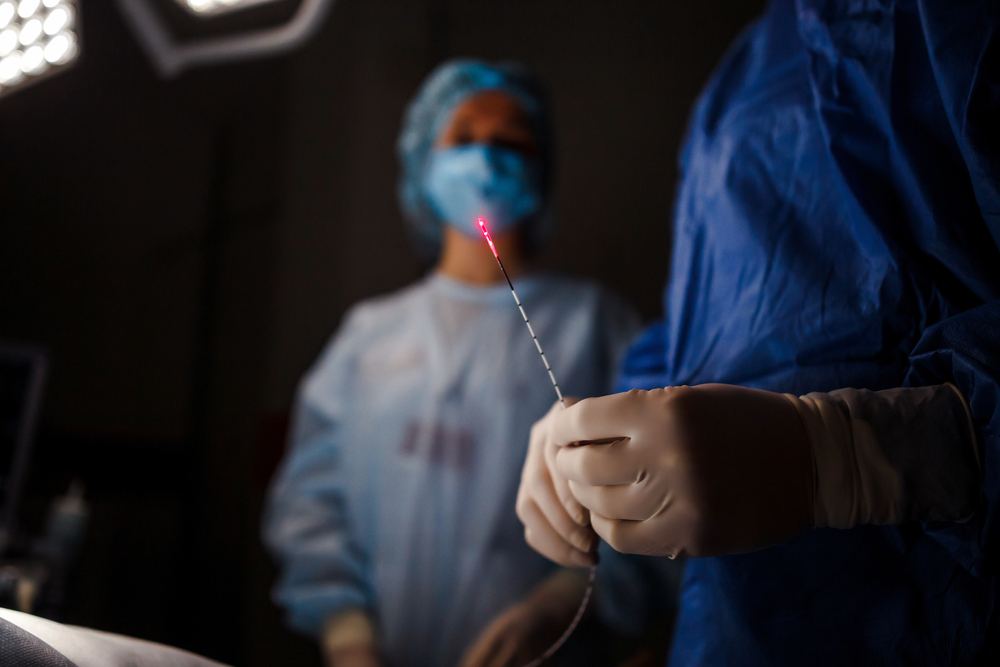As one of the most common conditions that exist, varicose veins affect one out of every two people 50 years of age and older, and 15-25 percent of all adults. Risk factors for developing varicose veins include age, family history, pregnancy, and long periods of daily standing or sitting. In addition to their appearance, the symptoms of these large, ropey, and often bunched-up veins include aching, throbbing, fatigue, and even chronic skin ulcers.
Although varicose veins are most often considered a cosmetic issue, their appearance can signal a more serious disorder. A common cause of varicose veins is venous insufficiency, which results from a decrease in blood flow from the leg veins up to the heart. This can cause the pooling of blood in the veins and a backward flow of blood. This inability to move blood back up the body against the pull of gravity can further promote varicose vein occurrence.
Fortunately, modern treatment options allow some relief from this issue. Laser treatments are an effective solution to the problem, and there are two common and successful options to choose from that many people with this condition turn to. Keep reading to learn about two effective laser treatments that can remove your varicose veins.
Simple Laser Treatment
 Simple laser treatment is a quick and non-invasive treatment. This type of treatment can eliminate spider veins and smaller varicose veins that are visible just under the skin. Perfect for those looking to eradicate the cosmetic symptoms and get back their summer-ready legs, simple laser treatment is often sought out for its ease of treatment and speedy visible results. Simple laser treatment is often performed multiple times in order to produce optimal results, and treatments are scheduled every 6 to 12 weeks apart.
Simple laser treatment is a quick and non-invasive treatment. This type of treatment can eliminate spider veins and smaller varicose veins that are visible just under the skin. Perfect for those looking to eradicate the cosmetic symptoms and get back their summer-ready legs, simple laser treatment is often sought out for its ease of treatment and speedy visible results. Simple laser treatment is often performed multiple times in order to produce optimal results, and treatments are scheduled every 6 to 12 weeks apart.
Simple laser treatment requires no downtime or special treatment post-procedure. It is a safe and effective option, allowing almost anyone with small varicose or spider veins to reap the rewards with little to no risk or out-of-pocket expense.
Sclerotherapy, radiofrequency, or endovenous laser treatments are often performed in advance of simple laser treatment in order to remove the veins that feed this smaller spider and varicose veins—keep reading to learn more.
Endovenous Laser Treatment
Endovenous laser treatment, on the other hand, is used for those who suffer from larger varicose veins. To treat these more intense issues, the doctor will use an ultrasound under which they will pass a laser through a catheter that is inserted into the vein.
Done under local anesthesia or sedatives, endovenous treatment is most often performed on the greater saphenous vein, where the optical fiber inserted into the vein uses infrared laser light to cause the vein to contract and eventually scar together and disappear.
A few minor complications, such as pain, hematoma, edema, or thrombophlebitis can occur, but most often patients are able to return to their daily routine immediately, although compression stockings should be worn for at least a week. A follow-up appointment is commonly scheduled so that the doctor can review the success of the treatment through a second ultrasound review. Endovenous laser treatments are 94% effective, making them a great treatment option for those suffering from large varicose veins.
Lasers have begun to replace the more traditional surgical treatment of varicose veins and for good reason. The shorter downtime, better results, fewer side effects, and increased comfort during the procedure are just a few of the ways that laser treatment has become the go-to treatment for getting rid of problematic varicose veins.



